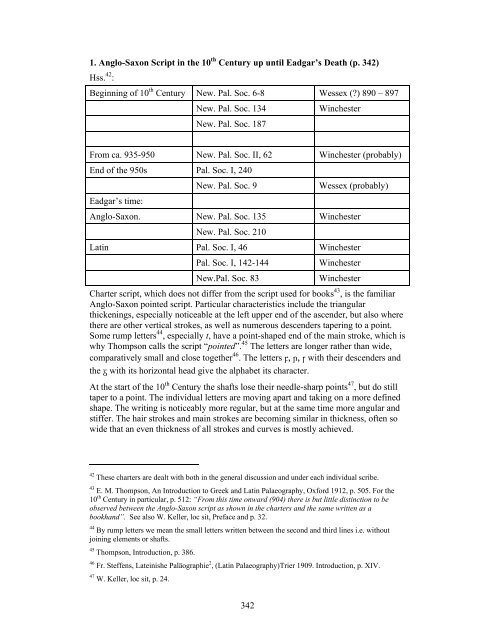Provisional Drogereit pdf
Provisional Drogereit pdf
Provisional Drogereit pdf
Create successful ePaper yourself
Turn your PDF publications into a flip-book with our unique Google optimized e-Paper software.
1. Anglo-Saxon Script in the 10 th Century up until Eadgar’s Death (p. 342)<br />
Hss. 42 :<br />
Beginning of 10 th Century New. Pal. Soc. 6-8 Wessex (?) 890 – 897<br />
New. Pal. Soc. 134<br />
New. Pal. Soc. 187<br />
Winchester<br />
From ca. 935-950 New. Pal. Soc. II, 62 Winchester (probably)<br />
End of the 950s Pal. Soc. I, 240<br />
Eadgar’s time:<br />
New. Pal. Soc. 9 Wessex (probably)<br />
Anglo-Saxon. New. Pal. Soc. 135<br />
New. Pal. Soc. 210<br />
Winchester<br />
Latin Pal. Soc. I, 46 Winchester<br />
Pal. Soc. I, 142-144 Winchester<br />
New.Pal. Soc. 83 Winchester<br />
Charter script, which does not differ from the script used for books 43 , is the familiar<br />
Anglo-Saxon pointed script. Particular characteristics include the triangular<br />
thickenings, especially noticeable at the left upper end of the ascender, but also where<br />
there are other vertical strokes, as well as numerous descenders tapering to a point.<br />
Some rump letters 44 , especially t, have a point-shaped end of the main stroke, which is<br />
why Thompson calls the script “pointed”. 45 The letters are longer rather than wide,<br />
comparatively small and close together 46 . The letters , , with their descenders and<br />
the with its horizontal head give the alphabet its character.<br />
At the start of the 10 th Century the shafts lose their needle-sharp points 47 , but do still<br />
taper to a point. The individual letters are moving apart and taking on a more defined<br />
shape. The writing is noticeably more regular, but at the same time more angular and<br />
stiffer. The hair strokes and main strokes are becoming similar in thickness, often so<br />
wide that an even thickness of all strokes and curves is mostly achieved.<br />
42 These charters are dealt with both in the general discussion and under each individual scribe.<br />
43 E. M. Thompson, An Introduction to Greek and Latin Palaeography, Oxford 1912, p. 505. For the<br />
10 th Century in particular, p. 512: “From this time onward (904) there is but little distinction to be<br />
observed between the Anglo-Saxon script as shown in the charters and the same written as a<br />
bookhand”. See also W. Keller, loc sit, Preface and p. 32.<br />
44<br />
By rump letters we mean the small letters written between the second and third lines i.e. without<br />
joining elements or shafts.<br />
45 Thompson, Introduction, p. 386.<br />
46 Fr. Steffens, Lateinishe Paläographie 2 , (Latin Palaeography)Trier 1909. Introduction, p. XIV.<br />
47 W. Keller, loc sit, p. 24.<br />
342
















